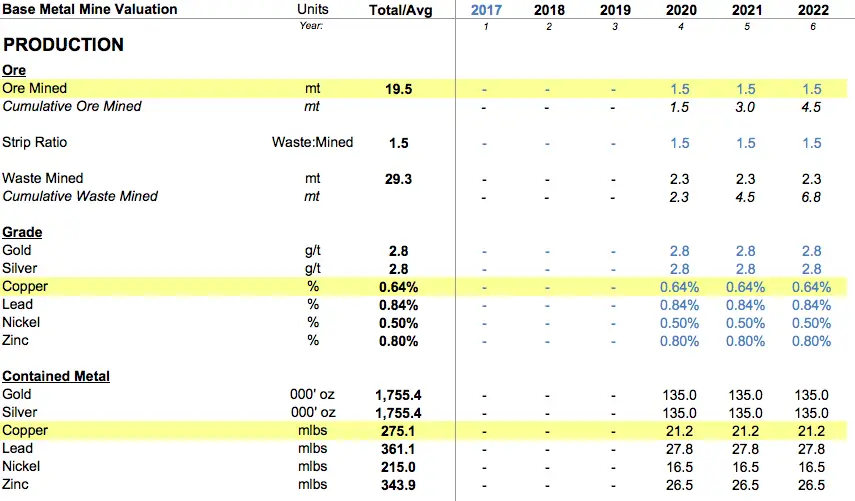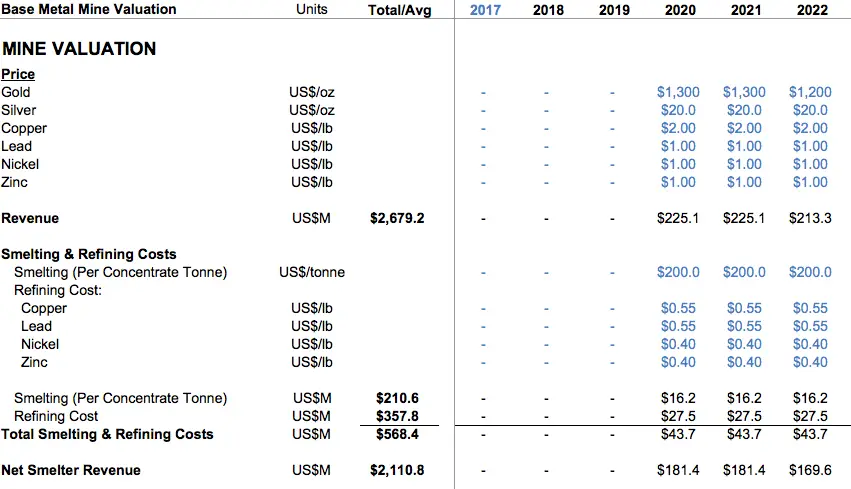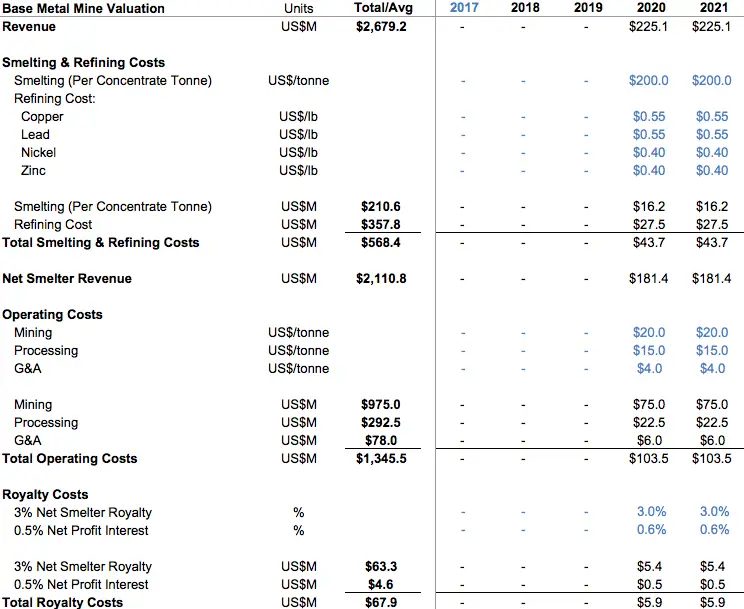Now that you know how to value a gold mine from the previous post, valuing a base metal mine should be easy because the steps are essentially the same.
What makes valuing a base metal mine – that is, copper, lead, nickel or zinc – more complicated than a gold mine or a silver mine is incorporating co-products and by-products. There are combinations of metals that are found in ore together. For example, common metals found together are: copper-gold or lead-silver-zinc. Often times, there will be one metal that is the primary product and the other is a by-product. Sometimes when both metals derive similar economic value (50/50), they are termed co-products.
So, the valuation model becomes more complex with base metals because there are more metals to deal with. (Note that just like the gold mine model provided in the previous post, a free base metal mine model is downloadable here too – just scroll to the bottom.
You will find that in this model, gold/silver/copper/lead/nickel/zinc are all listed. Depending on the mine you are valuing, input 0 for metals that are not found in the technical report.
Note also that all the numbers found in this model are hypothetical. That is the end of this particularly long note.)
The set of steps in extracting the necessary information from the technical report for a base metal mine is very similar. I won’t repeat them in detail here, so if you haven’t already, then I encourage you to read the previous post on how to value a gold mine (i.e. mine start year, reserves & resources, operating costs, capex, etc).
Once you’ve mastered that, all you need to know to value a base metal mine are:
Waste Ore & Strip Ratio
Waste ore applies to a gold mine as well, but where in a gold mine, the operating cash cost is expressed often in gold ounces produced such that you don’t need to break out waste ore and mined ore, this is not the case for a copper mine or a lead mine. Waste ore mined is a separate cost and is expressed as a cost per tonne of waste ore. Waste ore is calculated by multiplying mined ore by the strip ratio, as seen in the snapshot of the valuation model below:

Grade – %
The most noticeable difference between a precious metal mine and a base metal mine valuation is that the grade of copper, lead, nickel, and zinc are in %, not g/t. Typically, a grade above 1% for a primary product is considered average. If the primary product has a grade of <0.50%, then it is an expensive mine that can run into many hiccups.
Pounds (lbs)
Where gold is expressed in ounces, base metals are expressed in pounds (lbs). To calculate contained copper from mined ore, you multiply the mined ore (million tonnes) x grade (%) x 2204.62 (tonne-to-pound conversion). For example, 1.5million tonnes of ore mined x 0.64% copper grade x 2204.62 = 21.2 million pounds of copper.

Concentrate Tonnes & Grade
The primary base metal product will have a concentrate grade. This one is tricky to understand but basically, you reverse engineer from recovered pounds of the primary metal (e.g. copper) to tonnage of the concentrate. For example, copper concentrate produced of 0.1 million tonnes is derived by starting with:
17.9 million pounds of copper/ 2204.62 (pound-to-tonne conversion) / 10.0% copper concentrate grade (given in the technical report).

You need to find the concentrate produced because of smelting costs (more on this topic later).
Recovery rate is applied the same here as a gold mine valuation. Payability is treated the same as a recovery rate – multiply the percentage to the recovered metal(s).
Smelting & Refining Costs
One extra step in a base metal mine is calculating the smelting and refining costs – these costs are given in the technical report. Smelting cost is expressed as $ per tonne and you multiple this to the concentrate tonnes calculated just above. Refining cost is calculated by multiplying the payable metals by the refining cost per pound.

Operating Cost & Capex
These items are the same as a gold mine valuation. Note that operating cost items are expressed as per tonne of mined ore here, not as per ounce of gold produced.
Royalty (%) – NSR/NPI
NSR Royalty – I’ve also included hypothetical royalties in this model. Net Smelter Returns (NSR) royalty is the most common type of royalty on a mine. It is usually not more than 3% and is calculated by multiplying the NSR royalty percentage to the net smelter revenue (revenue minus the smelting & refining cost as defined above).
NPI Royalty – Net Profit Interest (NPI) royalty is less common. It is calculated as NPI royalty percentage multiplied by operating cash flow (revenue – smelting & refining cost – operating cost). It’s never a good sign when there is a high NPI like 10% as it puts a huge burden on the profitability of the mine.

Download Valuation Model For Free
As you can see, valuing a base metal mine is not that much different than valuing a gold mine except for the above differences.
Enter your email below to sign-up for the mailing list and the valuation model will be sent to your email directly.
*Model Tips*
Only input in blue font-colored cells. Start by choosing the primary metal at the top of the model first. This will flow through the rest of the model. And input 0 for metals that don’t apply in the mine you are valuing.
Good luck and hope you found this helpful. (Side note: when I used to work in this industry, old colleagues who had been in the industry for a long time recommended reading The Big Score about the mining mogul, Robert Friedland. Let’s just say that I am so glad I never had to work with a character like that ever. It’s a fascinating book regardless and anybody who foresees themselves being in the mining industry for a while should read it.)


Pingback: In GOLD We Trust – How To Value A Gold Mine (DOWNLOAD VALUATION MODEL FOR FREE)
Good material for reading, well appreciated!
Appreciate the comment, Samuel!
Hi,
I was interested in the valuation model for the gold and base metals, there is an error when submitting the e-mail. If you can e-mail it to me at jackshi.hb2018@ivey.ca, that would be great. Thanks!
Hi Jack. Sent it to your email. Hope it helps!
The link to download the model does not work. Can someone please email it to me at adam.hamade@ryerson.ca?
Hi Adam, check your email. I sent it to you. Thanks for visiting our site!
Hi, could you e-mail me the downloadable file? Thanks and great work. Congrats.
Hi Furkan,
The links are now fixed. I hope you find the model helpful. More to come.
Thanks.
Hi,
Please could you send the valuatiin model to my email, I cannot get it.
Tks.
Philip
Hi Philip, have you entered your email in the field above at the bottom of the article? It should send you the valuation model directly to your email.
This is really good, simple and charity on your part. If you offer more materials for learning, I would want to be updated. If there is anything else I could do to help, please do let me know.
Hi, please send me your template. I already entered my email in the field above.
Thanks, Jonathan
The model should be on the way to your inbox now. Thanks for reading!
Is this still available i cant see a form?
Yes it is, just signed you up for it. It’s on its way to your email now!
Great!
Thanks!
Sir, I have some questions for you. In the market i see there is a big difference between the price of copper and the price of high grade copper. Why and what is the difference between the two. Also i am very interested in investing in a startup copper/ zink/ nickel mine in South Africa called Orion mining. What grade would they produce? In your opinion does this mine sound like a viable proposition? Lastly viable gold reserves are declining rapidly does this also apply to copper?
Thanks in advance
Jan Ledoux.
Hi Jan, those are very good questions, but I am not qualified to answer them. I would suggest finding a forum and reaching out to them with these questions. Thanks for reading!
Hi!
Many thanks for doing this, super helpful! Is there any chance you could send me the excel via email, the field above does not work for me.
Hi Stefan, thanks for your comment and I’m happy to hear it was helpful! I set up the file sending automatically, but I’ve put your email in the field, so you should receive it in your inbox now!
Excellent article, very helpful. Could you please send me the download link.
Thanks Billy, the file should be in your inbox!
Awesome read and article – are you still sharing the financial model?
Thanks Hugh! I’ve set it up so that the model sends directly to your email – if you put your email below, it should arrive in your inbox! (If it you don’t receive it, it might’ve ended up in spam.)
Hi! I’ve tried to download the excel, but it didn’t work. Can you try to send it back directly to my email please? jo96@live.ca thanks a lot!
Hi Jonathan, thanks for your interest in the excel! On rare occasions, it takes a few hours or a day for the email to go through after putting your email in the field. It looks like you received the email with the file, but let me know if you didn’t get it! Cheers-